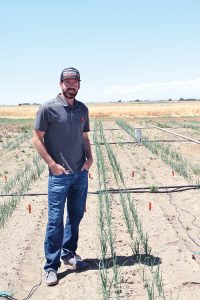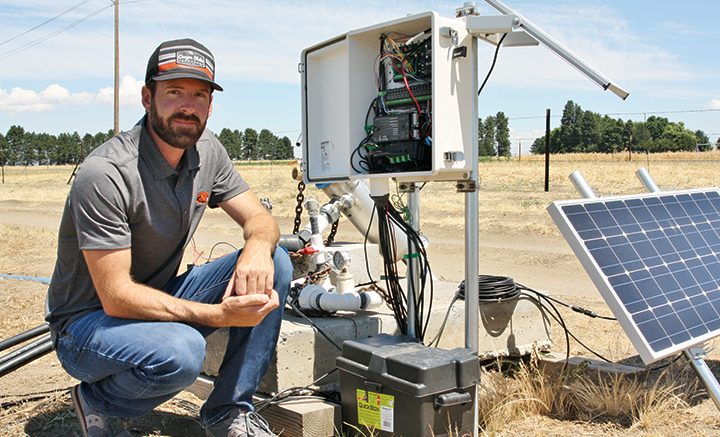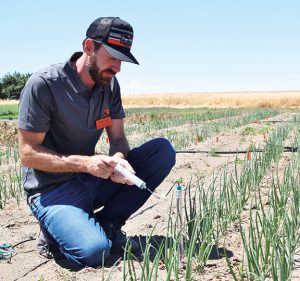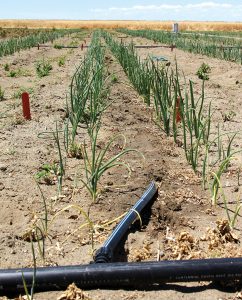Is Drip Irrigation Feasible in Sandy Soil?
Story and photos by Denise Keller, Editor
Despite the benefits of drip irrigation, the technology has yet to become the irrigation method of choice for most onion growers in the Umatilla Basin of Oregon. A lack of research-based recommendations specific to the region’s super sandy soil has kept many growers from making the move to drip.
But now, a research study at Oregon State University’s (OSU) Hermiston Agricultural Research and Extension Center aims to evaluate the efficacy of drip irrigation in the area’s coarse-textured soils.
Soil Moisture Monitoring
Scott Lukas, an assistant professor of horticulture with OSU, chose to conduct the research after identifying irrigation as an area with room for potential improvement in the region. Unlike onion production areas to the north and south that commonly use water-efficient drip irrigation, less than 10 percent of the onions in the Umatilla Basin are grown under drip irrigation, Lukas estimates.
Lukas’ research is one of the first studies of drip irrigation in such sandy soil, he says. The work focuses on soil moisture monitoring and is designed to determine when to initiate irrigation and model where water moves from the drip emitters.
“Field men have a ton of experience and can look at the soil and see what the crop needs, but it doesn’t hurt to have a little more data behind it to see what’s happening underground,” Lukas explains.
In this first year of the project, Lukas is evaluating four treatments including two drip tape flow rates: ultra-low and low. For each, water is set to turn on at two soil moisture onset thresholds: 20 centibars (cb) and 10 cb. A network of sensors measure soil moisture values every 30 minutes. In turn, the system logs the data and directs valves to turn on or off.
With the ultra-low flow drip tape typically used in areas with denser soil, water tends to move straight downward through Hermiston’s sandy soil, rather than laterally toward the crop rows. Thus, Lukas is looking at low-flow drip tape as a means of pushing water laterally toward the onion row.
Lukas will compile preliminary data this fall and plans to continue and expand the trial during the next two years.
Potential Benefits
Ultimately, this research could help the local onion industry experience the benefits of drip irrigation. Designed to deliver water and nutrients directly to the root zone of the crop, drip irrigation can save water, reduce disease pressure, increase quality and yield, and reduce fertilizer costs and nitrate-leaching losses, according to Lukas.
As part of his study, Lukas is trying to determine how much nitrogen is being lost with each of the various irrigation treatments. Treatments that put more water down through the soil profile are most likely resulting in nitrate leaching, as well, he says.
“Reducing water use coupled with reducing nitrate leaching are two of the most fundamental challenges that all agriculture in this region is going to face,” Lukas says, adding that the nitrate leaching issue might eventually lead to legislation that could restrict fertilizer usage to some extent. “The best thing growers can do is to continue to be proactive and keep adopting new strategies so that when the legislature does look at it, it shows that they’re working on it.”
Lukas adds that growers in the region currently are utilizing many leading-edge farming practices and that the possibility of expanding and improving on those methods is very exciting. Based on what he’s seeing in the study so far, Lukas says the prospect of using drip irrigation in the region looks promising, and he believes it will become more widely implemented in the future.
“With the water scarcity issues, this is the world we’re living in. In all of agriculture, water is a precious resource. The smarter we can be with it and the more precise we can be, the better,” he says. “That’s what this is. This is precision ag at its greatest.”

Scott Lukas with Oregon State University is working to develop drip irrigation recommendations specific to the sandy soils in the Umatilla Basin.



